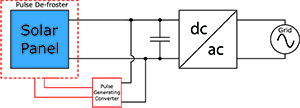Analysis and Design of Pulse De-icing on Solar Panels
MS student Mingrui Zhu with advisor A.Stillwell
Under extreme cold conditions, a de-icing or de-frosting method is needed to maintain the normal function of solar panels and the grid system of which they are a part. A pulse de-icing method is proposed as an alternate for the traditional chemical method (by spraying defrosting fluid) because of its overall energy used and environmental benefits.
We finished the analysis of the conventional de-icing methods applied both on electric aircraft and solar panels, with the focus primarily on the power rating (if applicable) and time performance. The first phase of the circuit-level design with emphasis on the dc/ac bidirectional inverter, shown in Figure 22, is completed. We achieved the designated power performance, as well as maintained a proper power factor. As shown in Figure 22, the pulse-generating converter extracts partial energy delivered by the solar panel to accomplish the de-icing task, which sustains the solar panel operation against extreme weather. For future work, the second phase of the circuitry design would be continued, mainly focusing on the study of the high power-density pulse-generating converter. In addition, the hardware layout and verifications of the actual performance will be explored. This research is supported by the Grainger CEME.
